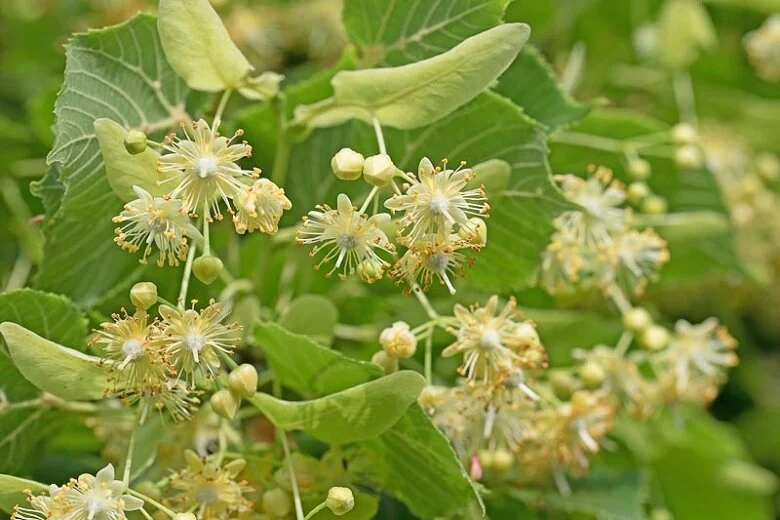Linden tree blossom
Lime leaves
Common Name: Small-leaved Lime Tree, Linden, Basswood
Genus & Species: Tilia cordata Mill.
Family: Malvaceae
Other Similar Species:
Similar species are the Large-leaved Lime (Tilia platyphyllos) and the hybrid Common Lime (Tilia x europaea). American Basswood (Tilia Americana) and Japanese Lime (Tilia japonica) are rarely found in the UK but are otherwise similarly used.
Range and Habitat:
T. cordata is a native of British woodlands, and the genus Tilia is found in temperate forests throughout the northern hemisphere. T. x europaea is a popular street tree.
General ID:
Lime trees are large deciduous trees which can grow to more than 20m high. Their bark is grey-brown and smooth and develops flaky plates with age. The twigs are brown-red in the shade, but become shiny in sunlight. They may produce suckers from the base of the tree. It is possible to tell true species apart by the underside of the leaf. T. cordata (Small-leaved Lime) has heart-shaped leaves with a pointed tip, 3–8cm in length, and hairless except for reddish to brown tufts on the underside of the vein-joints. Tilia x europaea (Common lime) has tufts of white hairs between the vein joints, whereas these are rusty red in small-leaved lime. Tilia platyphyllos (Large-leaved lime) has hairs all over the underside, and its leaves are bigger as the common name implies. The flowers are green-yellow, have five petals, and hang in clusters of 4–10 underneath a narrow leafy bract. They have a rich, heavy scent and develop into round-to-oval, smooth fruits with pointed tips.
For food…
The young leaves are mild tasting and can be eaten raw. They make an excellent salad or sandwich filling. As it is a distant cousin of the Chocolate Tree (Theobroma cacao) it can offer a very acceptable chocolate substitute made from a paste of the ground-up flowers and immature fruit, however this has a short shelf-life which prevented commercial exploitation. A popular herb tea is made from the flowers, it has a sweet, fragrant pleasant flavour. Some caution is advised, as they contain minute traces of nicotinoids. Honey from Lime flowers is popular and of good flavour. Its sweet sap can be harvested in the spring, which can be drunk immediately or concentrated into a syrup.
For healing…
Lime flowers have been used in the treatment of colds and other ailments where sweating is desirable. A tea made from the fresh or dried flowers is antispasmodic, diaphoretic, expectorant, hypotensive, laxative and sedative. Lime flower tea is also used internally in the treatment of indigestion, hypertension, hardening of the arteries, hysteria, nervous vomiting, headaches or migraines and for palpitations. Some recent evidence suggests it may also protect the liver. Only fresh flowers should be used, older flowers can become narcotic. A charcoal made from the wood is used in the treatment of gastric or dyspeptic disturbances and is also made into a powder then applied to burns or sore places.
In culture…
As the name Basswood may suggest, a strong fibre can be obtained from the bark which can be used in multiple applications. It is the traditional material the Ainu of Japan make their clothing from and was used in prehistoric Britain and Europe. Ötzi the Iceman, a Neolithic mummy found in the alps, wore clothing made from it. Wood from Tilia species is also highly prized being supple and light. It has many cultural connotations in Europe. In France sitting under it was believed to cure epilepsy, it is the national tree of Slovenia, is celebrated as a symbol of fertility in Estonia and Lithuania, has been associated with justice in Germanic folklore and its association with love is celebrated in the traditional Moldovan/Romanian song Dragostea Din Tei made popular in modern times by the boyband O-zone.
For wildlife…
Lime leaves are eaten by the caterpillars of many moth species, including the Lime Hawk Moth (Mimus tiliae), Peppered Moth (Biston betularia), Vapourer Moth (Orgyia antiqua), Triangle Moth (Heterogenea asella) and Scarce Hook-Tip Moth (Sabra harpagula). They are very attractive to aphids, providing a source of food for their predators, including hoverflies, ladybirds and many species of bird. The flowers provide nectar and pollen for insects, particularly bees, which also drink aphid honeydew from lime leaves. Ants have been known to farm these aphids, and honeydew will often drop making the lower leaves sticky. Bees have been known to become addicted to the nectar, possibly because of the nicotinoids, and have been known to die from excessive consumption. Long-lived trees provide dead wood for wood-boring beetles, and nesting holes for birds. Leaves of suckers are popular with deer. The mite Eriophyes tiliae will sometimes cause red spikes called Lime Nail Galls to occur on the leaves.
At FFPG…
Tilia cordata makes an appearance in our recently planted Forest Garden area!
Disclaimer:
This is intended for information only. FFPG, its staff, trustees and volunteers do not make any claim as to the safety or efficacy of plants listed for medicinal purposes and do not encourage the consumption or use of any of the plants listed herein. Anybody wishing to use plants for medicinal effect is advised to consult their medical professional.
Lime tree fruit




